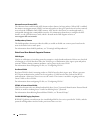
26 Introduction
Alternate Store and Forward (ASF)
The Alternate Store and Forward (ASF) feature reduces latency for large packets. When ASF is enabled,
the memory management unit (MMU) can forward a packet to the egress port before it has been entirely
received on the Cell Buffer Pool (CBP) memory. AFS, which is also known as cut-through mode, is
configurable through the command-line interface. For information about how to configure the AFS
feature, see the
CLI Reference Guide
, which is located on the Dell Support website at
www.support.dell.com/manuals.
Link Dependency Features
The link dependency feature provides the ability to enable or disable one or more ports based on the
state of the link of one or more ports.
For information about Link Dependency, see "Creating Link Dependencies."
Virtual Local Area Network Supported Features
VLAN Support
VLANs are collections of switching ports that comprise a single broadcast domain. Packets are classified
as belonging to a VLAN based on either the VLAN tag or a combination of the ingress port and packet
contents. Packets sharing common attributes can be groups in the same VLAN.
For information about configuring VLANs, see "Configuring VLANs."
Port-Based VLANs
Port-based VLANs classify incoming packets to VLANs based on their ingress port. When a port uses
802.1X port authentication, packets can be assigned to a VLAN based on the result of the 802.1X
authentication a client uses when it accesses the switch. This feature is useful for assigning traffic to
Guest VLANs or Voice VLANs.
For information about configuring VLANs, see "Configuring VLANs."
IEEE 802.1v Protocol-Based VLANs
VLAN classification rules are defined on data-link layer (Layer 2) protocol identification. Protocol-based
VLANs are used for isolating Layer 2 traffic for differing Layer 3 protocols.
For information about defining Protocol-Based VLANs, see "Protocol Group."
Full 802.1Q VLAN Tagging Compliance
IEEE 802.1Q defines an architecture for virtual bridged LANs, the services provided in VLANs, and the
protocols and algorithms involved in the provision of these services.


















